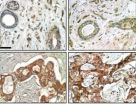(Press-News.org) LA JOLLA, CA, September 11, 2012 – Scientists at The Scripps Research Institute have found a new technique that should greatly speed the discovery of medically and scientifically useful antibodies, immune system proteins that detect and destroy invaders such as bacteria and viruses. New methods to discover antibodies are important because antibodies make up the fastest growing sector of human therapeutics; it is estimated that by 2014 the top-three selling drugs worldwide will be antibodies.
The new technique, described in an article this week published online ahead of print by the journal Proceedings of the National Academy of Sciences, enables researchers to search large libraries of antibodies and quickly select the ones with a desired biological effect. It also provides for the creation of unusual, asymmetric antibodies whose capabilities extend beyond those of natural antibodies. The Scripps Research scientists demonstrated the power of the technique by using it to find an asymmetric antibody that almost perfectly mimics the activity of erythropoietin (EPO), a medically valuable hormone.
"Traditionally we've looked at antibodies as tools for binding to specific targets, but we should view them more generally, as tools for probing and altering functions in cells," said Richard Lerner, the Lita Annenberg Hazen Professor of Immunochemistry and member of the Department of Molecular Biology at Scripps Research who led the new study.
At the Vanguard
Lab-grown antibodies already represent a major part of the ongoing biotechnology revolution. Used as scientific probes or medical therapies, they recreate the versatility of natural antibodies, which are produced by immune cells in a vast diversity to bind to highly specific shapes on viruses, bacteria, and other targets.
Two decades ago, Lerner and his laboratory at Scripps Research, in parallel with the group of Sir Gregory Winter at the Laboratory of Molecular Biology in Britain, developed the first techniques for generating very large libraries of combinatorial antibodies and quickly isolating those that can bind to a desired target. Since then, such techniques have been used to find antibodies to treat cancer, arthritis, transplant rejection, and other conditions. Humira, an anti-inflammatory antibody that was discovered this way, is expected to be the world's top-selling drug this year. Belimumab (Benlysta®) was approved by the US Food and Drug Administration in 2011 to treat lupus, becoming the first new drug to treat the chronic, life-threatening inflammatory disease in more than 50 years.
Current antibody-discovery techniques have one big drawback, however. Although they can rapidly find antibodies that bind tightly to a known target, they can't rapidly determine which of those antibodies has useful biological activity. An antibody may bind tightly to a virus without affecting the virus's ability to infect cells, for example, or it may bind to a cellular receptor without activating that receptor. With current techniques, determining the overall biological effect of a target-binding antibody typically requires further, painstaking analysis.
A More Direct Path
In the new study, Lerner and his postdoctoral researcher Hongkai Zhang sought a method for rapidly finding antibodies that have a desired effect on cells, not just a desired ability to bind to a target. As a proof of principle, they aimed to discover an antibody that could mimic the activity of EPO, a hormone that stimulates red blood cell production. Drugs that mimic EPO's effect are commonly used to treat anemia and related conditions.
Zhang began by using traditional techniques to quickly sift through a large antibody library to find tens of thousands of antibodies that bind tightly to the EPO receptor. He then stepped beyond traditional techniques, by taking the genes that encoded these EPO-receptor-binding antibodies and inserting them into lentiviruses. Unlike the phage viruses used in traditional methods, lentiviruses can usefully infect mammalian cells, delivering their payloads – antibodies, in this case – into a more human-like cellular environment.
Zhang applied this new library of antibody-coding lentiviruses to a single, large culture of mammalian test cells. The cells were of a type that express EPO receptors and proliferate when these receptors are bound by EPO proteins – or by antibodies that effectively mimic EPO. Each of these cells could host only a few viral particles at most, so in this way Zhang was able to distribute the entire library of EPO-receptor-binding antibodies broadly within the cell culture. Zhang also cultured the cells in a special way that prevented antibodies secreted by one cell from spreading easily to nearby cells and muddying any cause-effect relationship. "This concern over the diffusion of antibodies in the culture was one of the factors that had discouraged other researchers from using such a technique," said Zhang.
After the lentiviruses had delivered the antibodies to the cultured cells, Zhang was able to note which cells were proliferating the most – signifying the presence of antibodies that mimic EPO. To identify the antibodies responsible, Zhang had only to harvest these faster-growing cells and sequence the antibody genes inside them.
This method quickly yielded an antibody that in a further test showed about 60 percent of the biological activity of natural EPO – which was as good as any antibody EPO-mimic that had ever been described.
Opening the Door to the Unknown
But Zhang and Lerner also noted that many of the proliferating cells had been infected by multiple lentivirus particles, and contained sequences from more than one antibody. Puzzlingly, Zhang found that when he recreated antibodies from these sequences, and tested them individually or in combinations, they showed no significant EPO-mimicking effect. Further tests showed that the source of the EPO-mimicking effect in the test cells was an antibody that does not occur naturally.
An antibody of the type used in the study has a Y-shaped structure, normally with two identical binding arms. But the presence of multiple antibody genes within some of Zhang's test cells meant that, in a few cases, antibodies assembled themselves with two different binding arms. One of these "bispecific" antibodies turned out to bind to the EPO receptor – which has two binding sites – in a way that very accurately mimics the binding of a natural EPO molecule. "It turned out to be 100 percent as potent as authentic EPO in further tests," Zhang said.
The serendipitous finding represents another major innovation, for, in principle, it extends the medical and scientific antibody repertoire from the 100 billion or so known variants of same-armed antibodies to an astronomically higher number of bispecific variants. Experiments to test such variants will be limited by the maximum number of usable cells in cultures, but that number is still very high, on the order of 10 million. "That allows for a lot of unique binding events," said Lerner. "You probably can get almost anything that way."
Lerner emphasizes that this new antibody-engineering/discovery technique can be used not just against known targets such as the EPO receptor, but also against cellular functions involving targets that have not yet been found. "The real power of this technique is its ability to help us discover the unknown," he said.
INFORMATION:
Another author of the study, titled "Selection of antibodies that regulate phenotype from intracellular combinatorial antibody libraries," was Ian A. Wilson, the Hansen Professor of Structural Biology at Scripps Research and an expert on the structure of the EPO receptor. For more information on the paper, see http://www.pnas.org/content/early/2012/09/05/1214275109.abstract
Scripps Research scientists devise powerful new method for finding therapeutic antibodies
The technique hones and expands the power of large numbers
2012-09-12
ELSE PRESS RELEASES FROM THIS DATE:
Ageism presents dilemmas for policymakers worldwide
2012-09-12
The negative consequences of age discrimination in many countries are more widespread than discrimination due to race or gender, yet differential treatment based on a person's age is often seen as more acceptable and even desirable, according to the newest edition of the Public Policy & Aging Report (PP&AR). This publication, which features cross-national perspectives, was jointly produced by The Gerontological Society of America (GSA) and AGE UK.
The PP&AR explores how discriminatory behaviors manifest themselves, steps that are being taken to address those behaviors, ...
Sliding metals show fluidlike behavior, new clues to wear
2012-09-12
"We see phenomena normally associated with fluids, not solids," said Srinivasan Chandrasekar, a professor of industrial engineering at Purdue University, working with postdoctoral research associates Narayan Sundaram and Yang Guo.
Numerous mechanical parts, from bearings to engine pistons, undergo such sliding.
"It has been known that little pieces of metal peel off from sliding surfaces," Chandrasekar said. "The conventional view is that this requires many cycles of rubbing, but what we are saying is that when you have surface folding you don't need too many cycles for ...
NASA's Global Hawk investigating Atlantic Tropical Depression 14
2012-09-12
NASA's Hurricane and Severe Storm Sentinel (HS3) airborne mission sent an unmanned Global Hawk aircraft this morning to study newborn Tropical Depression 14 in the central Atlantic Ocean that seems primed for further development. The Global Hawk left NASA's Wallops Flight Facility on Wallops Island, Va., this morning for a planned 26-hour flight to investigate the depression.
NASA's latest hurricane science field campaign began on Sept. 7 when the Global Hawk flew over Hurricane Leslie in the Atlantic Ocean. HS3 marks the first time NASA is flying Global Hawks from the ...
Scrub jays react to their dead
2012-09-12
Western scrub jays summon others to screech over the body of a dead jay, according to new research from the University of California, Davis. The birds' cacophonous "funerals" can last for up to half an hour.
Anecdotal reports have suggested that other animals, including elephants, chimpanzees and birds in the crow family, react to dead of their species, said Teresa Iglesias, the UC Davis graduate student who carried out the work. But few experimental studies have explored this behavior.
The new research by Iglesias and her colleagues appears in the Aug. 27 issue of ...
Protein linked to therapy resistance in breast cancer
2012-09-12
A gene that may possibly belong to an entire new family of oncogenes has been linked by researchers with the U.S. Department of Energy (DOE)'s Lawrence Berkeley National Laboratory (Berkeley Lab) to the resistance of breast cancer to a well-regarded and widely used cancer therapy.
One of the world's leading breast cancer researchers, Mina Bissell, Distinguished Scientist with Berkeley Lab's Life Sciences Division, led a study in which a protein known as FAM83A was linked to resistance to the cancer drugs known as EGFR-TKIs (Epidermal Growth Factor Receptor-Tyrosine Kinase ...
What are the effects of the Great Recession on local governments?
2012-09-12
Freezing positions and cutting workforces
Trimming pension and health care costs and passing them to employees
Lowering service delivery levels, but not imposing many new fees
Using technology to reduce costs where possible
Receiving added pressure but little help from States and the Federal Government
This important new research sheds light on the challenges faced by city and county governments that must provide most basic services. Unlike federal or state governments, these local governments have limited ability to generate revenue and are often mandated to pay for ...
NASA infrared data reveals fading Tropical Storm Leslie and peanut-shaped Michael
2012-09-12
When NASA's Aqua satellite passed over the Atlantic on Sept. 11 it caught Tropical Storm Leslie's clouds over Newfoundland and peanut-shaped Tropical Storm Michael to its southwest. The Atmospheric Infrared Sounder (AIRS) instrument captured infrared data on Tropical Storms Leslie and Michael when it passed overhead on Sept. 11.
Michael Appears Peanut-Shaped on Satellite Imagery
Tropical Storm Michael forecast to become a remnant low later today, Sept. 11, but as of 11 a.m. EDT Michael still had maximum sustained winds near 45 mph (75 kmh). It was located about 1,090 ...
Yellow lights mean drivers have to make right choice -- if they have time
2012-09-12
A couple of years ago, Hesham Rakha misjudged a yellow traffic light and entered an intersection just as the light turned red. A police officer handed him a ticket.
"There are circumstances, as you approach a yellow light, where the decision is easy. If you are close to the intersection, you keep going. If you are far away, you stop. If you are almost at the intersection, you have to keep going because if you try to stop, you could cause a rear-end crash with the vehicle behind you and would be in the middle of the intersection anyway," said Rakha, professor of civil ...
Genetic make-up of children explains how they fight malaria infection
2012-09-12
Researchers from Sainte-Justine University Hospital Center and University of Montreal have identified several novel genes that make some children more efficient than others in the way their immune system responds to malaria infection. This world-first in integrative efforts to track down genes predisposing to specific immune responses to malaria and ultimately to identify the most suitable targets for vaccines or treatments was published in the Proceedings of the National Academy of Sciences by lead author Dr. Youssef Idaghdour and senior author Pr. Philip Awadalla, whose ...
Scientists discover how the brain ages
2012-09-12
The ageing process has its roots deep within the cells and molecules that make up our bodies. Experts have previously identified the molecular pathway that react to cell damage and stems the cell's ability to divide, known as cell senescence.
However, in cells that do not have this ability to divide, such as neurons in the brain and elsewhere, little was understood of the ageing process. Now a team of scientists at Newcastle University, led by Professor Thomas von Zglinicki have shown that these cells follow the same pathway.
This challenges previous assumptions ...
LAST 30 PRESS RELEASES:
Making lighter work of calculating fluid and heat flow
Normalizing blood sugar can halve heart attack risk
Lowering blood sugar cuts heart attack risk in people with prediabetes
Study links genetic variants to risk of blinding eye disease in premature infants
Non-opioid ‘pain sponge’ therapy halts cartilage degeneration and relieves chronic pain
AI can pick up cultural values by mimicking how kids learn
China’s ecological redlines offer fast track to 30 x 30 global conservation goal
Invisible indoor threats: emerging household contaminants and their growing risks to human health
Adding antibody treatment to chemo boosts outcomes for children with rare cancer
Germline pathogenic variants among women without a history of breast cancer
Tanning beds triple melanoma risk, potentially causing broad DNA damage
Unique bond identified as key to viral infection speed
Indoor tanning makes youthful skin much older on a genetic level
Mouse model sheds new light on the causes and potential solutions to human GI problems linked to muscular dystrophy
The Journal of Nuclear Medicine ahead-of-print tip sheet: December 12, 2025
Smarter tools for peering into the microscopic world
Applications open for funding to conduct research in the Kinsey Institute archives
Global measure underestimates the severity of food insecurity
Child survivors of critical illness are missing out on timely follow up care
Risk-based vs annual breast cancer screening / the WISDOM randomized clinical trial
University of Toronto launches Electric Vehicle Innovation Ontario to accelerate advanced EV technologies and build Canada’s innovation advantage
Early relapse predicts poor outcomes in aggressive blood cancer
American College of Lifestyle Medicine applauds two CMS models aligned with lifestyle medicine practice and reimbursement
Clinical trial finds cannabis use not a barrier to quitting nicotine vaping
Supplemental nutrition assistance program policies and food insecurity
Switching immune cells to “night mode” could limit damage after a heart attack, study suggests
URI-based Global RIghts Project report spotlights continued troubling trends in worldwide inhumane treatment
Neutrophils are less aggressive at night, explaining why nighttime heart attacks cause less damage than daytime events
Menopausal hormone therapy may not pose breast cancer risk for women with BRCA mutations
Mobile health tool may improve quality of life for adolescent and young adult breast cancer survivors
[Press-News.org] Scripps Research scientists devise powerful new method for finding therapeutic antibodiesThe technique hones and expands the power of large numbers






